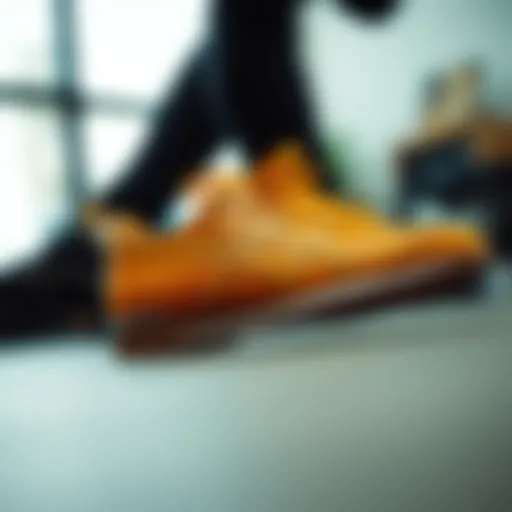The Evolution and Trends of Plus Size Denim Pants


Intro
The world of fashion is ever-evolving, and denim pants have maintained an enduring presence throughout this journey. However, the landscape for plus-size denim has undergone significant transformations, becoming a beacon of inclusivity in recent years. Historically, plus-size denim often lacked styling options and adequate fit, leaving many consumers feeling left out in the cold. This article aims to unpack the journey of plus-size denim, exploring how this segment of the fashion industry has broadened its horizon, reflecting changing attitudes towards body positivity and representation.
As we delve into the fabric of plus-size fashion, we'll discuss the current trends, the key styles making waves in the marketplace, and the influential designers leading the charge. We will also offer practical fashion advice to navigate the evolving world of plus-size denim, ensuring consumers can make mindful choices that suit their personal flair, while also being comfortable and stylish. Rather than glossing over the challenges faced by this demographic, we will confront them head-on – evaluating material innovations, fit complexities, and the importance of authentic representation.
With this foundation laid, let’s step into the vibrant tapestry of plus-size denim that is now, more than ever, a testament to inclusivity in fashion.
Intro to Plus Size Denim
The exploration of plus size denim signifies more than just garments; it's a journey into the evolution of fashion sensibility, cultural shifts, and the growing acknowledgment of inclusivity in the industry. As we delve into the narrative of plus size denim, we illuminate its significance in fostering self-acceptance and representation. It's not merely about the fabric that touches our skin; it’s about the voices and bodies that surround it.
Defining Plus Size in the Fashion Industry
Defining plus size within the fashion realm can be a bit of a slippery slope. Traditionally, the term has been associated with sizes that deviate from the so-called mainstream, often beginning at size 14 or larger in the United States. Yet, the term varies drastically from one culture to another and across different retailers. In fact, some brands have effectively carved out their niches, branding certain size ranges as plus while others consider the same dimensions standard. This fragmentation points to an ongoing debate about societal norms and expectations surrounding body image.
In the current climate, there's a resurgence of dialogue emphasizing body positivity and acceptance. Fashion brands are beginning to recognize that all bodies deserve fashionable options, pushing for inclusive size ranges that extend beyond traditional definitions. This shift in understanding is pivotal, as it encourages a broader array of silhouettes and styles, allowing consumers to express their individuality without feeling confined by size labels.
The reality is that it’s not just about the numbers on a tag. Plus size fashion is a statement, incorporating designs that embrace curves, enhance shapes, and, ultimately, celebrate the body's diversity.
Historical Context of Denim in Plus Sizes
The history of denim tailored for plus sizes intertwines with social and economic transformations. In its earliest days, denim was a fabric worn predominantly by laborers and the working class, and body diversity was largely ignored in its sartorial creation. However, as the 20th century rolled into full swing, denim’s versatility began to shine. It evolved from mere workwear to a fashion staple embraced by many.
In the mid-20th century, there was a significant void in the marketplace for plus size denim. Brands offered limited options, often overlooking the aesthetic and fit needs of larger consumers. It wasn't until the late 90s and early 2000s that a noticeable shift began to happen. A burgeoning movement emerged, fueled by a call for representation in the fashion community. The internet and social media emerged as powerful platforms, allowing voices of advocates and consumers to demand better choices.
This historical backdrop sheds light on today’s landscape, where more brands, like ASOS Curve and Eloquii, are dedicated to producing stylish plus size denim. These brands cater explicitly to the curves and shapes often neglected in traditional fashion narratives, laying the groundwork for an inclusive future in clothing.
"What we wear can often express our identity and how we see ourselves. Plus size denim is a crucial fabric in that story, encompassing the journey toward visibility and respect in fashion."
As society continues to evolve, the trajectory of plus size denim will undoubtedly shape and reflect the ongoing strides towards inclusivity and body positivity.
Fabric and Materials Used
When discussing plus size denim, the fabric and materials used are crucial to understanding how style meets functionality. The right fabrics not only offer comfort but also serve to enhance the silhouette of plus size denim wearers. Quality fabrics consider elasticity, breathability, and durability, all important factors in ensuring that a garment not only fits well but also stands the test of time. Moreover, as the plus size market has evolved, so have the demands of consumers seeking variety that accommodates their specific needs and preferences.
The line between traditional and innovative fabric choices can dictate trends within this segment of fashion. Thus, this section aims to highlight the role materials play in the evolution of plus size denim.
Cotton Blends: A Staple in Plus Size Denim
Cotton blends have long been the backbone of plus size denim; a trusted choice offering both comfort and structure. The versatility of cotton allows for a garment that is not only soft against the skin but also robust enough to support an hourglass figure or more. However, what's increasingly popular is the addition of synthetics such as spandex or elastane. These materials lend elasticity to denim, allowing for a fit that hugs the curves without overly restricting movement. This blend creates a breathable fabric that adapts to body shape, ensuring wearers feel at ease throughout the day.
An example of this can be seen in brands like ASOS or Torrid, which have honed in on cotton blends to deliver denim products that consistently meet a standard for quality. It's common to find blends that are anywhere from 95% cotton to 5% spandex, striking a balance between comfort and shape retention. The result is a tailored look that enhances the wearer rather than hiding them under excess fabric.
Moreover, one must consider how the weight of the fabric plays a role in the overall look. Lighter blends can lend themselves to a more casual outfit, while heavier blends project a more structured finish, ideal for dressier occasions.
Innovative Fabrics and Technologies
While cotton blends remain a staple, the future of plus size denim is firmly rooted in innovation. Contemporary brands are now leveraging technological advancements to create fabrics that address specific needs, from moisture-wicking properties for hot climates to sustainable production methods. One such innovation is the introduction of water-saving processes and eco-friendly materials into denim production.
For instance, companies like Levi's have developed their WaterLess technology, which has significantly reduced the amount of water used in the finishing process. Such approaches serve a dual purpose, catering to the eco-conscious consumer while also attracting an audience that values sustainability in fashion.
Furthermore, there are new developments in the realm of performance fabrics, such as those with built-in cooling features or anti-odor properties. This not only highlights a forward-thinking design philosophy but addresses the lifestyle needs of many plus size wearers. The introduction of features like stretch and recovery technology allows for improved wear over time, ensuring that the denim maintains its shape, fabric integrity, and fit.
"Many modern consumers view clothing not just as fashion, but also as an extension of themselves, leading to the embrace of performance attributes in everyday wear."
In summary, as consumer demands evolve, so will the fabrics that cater to them. Successful brands will likely continue to explore and incorporate new materials and technologies, redefining the landscape of plus size denim. This evolution not only supports wearers in finding their ideal fit but also encourages a broader acceptance of diverse body types in the fashion industry.
Fit and Comfort Considerations


The significance of fit and comfort when it comes to plus size denim pants cannot be overstated. For many, the right fit contributes to confidence and self-expression. Denim should not just be a fabric for clothing; it should enhance one’s silhouette and provide a feeling of ease throughout the day. When plus-size individuals find clothing that fits well, it can empower them to embrace their personal style without worrying about discomfort.
Understanding Body Shapes and Sizes
Each body is uniquely shaped, and understanding these variations is critical for designing inclusive plus size denim. Not every curvy person shares the same proportions. For instance, some may have larger hips with a narrower waist, while others may carry weight differently. Knowing these shapes allows designers to create options that cater to each distinct demographic.
Recognizing common body shapes within the plus-size category—including apple, pear, and hourglass—is essential. Each shape suggests a specific fit consideration, such as how high the waistband should sit or the proportion of flare in a pant leg.
Cut and Design: What Works Best?
When it comes to cut and design, there are two standout styles that have made waves in the plus size denim scene: high-waisted and bootcut vs. skinny jeans. These styles cater to various body shapes and personal preferences, amplifying comfort while enhancing appearance.
High-Waisted Styles
High-waisted styles are becoming increasingly popular among individuals seeking functionality paired with fashion. The defining feature of high-waisted jeans is their waistline, which rises above the natural waist. This design not only creates an elongated torso but also offers support and comfort, effectively swirling in a bit of nostalgia for those who remember how flattering they were in the past.
The unique feature of high-waisted styles is the way they smooth out the midsection, creating a sleek silhouette. Many find them more comfortable than other cuts since they provide a far greater range of movement while also preventing any unwanted slipping or discomfort. However, some individuals might feel restricted if the denim lacks stretch, which could necessitate a careful selection of fabrics.
Bootcut vs. Skinny
The bootcut versus skinny debate has been ongoing for quite some time, and for a good reason; both styles deliver distinct advantages. Bootcut jeans, characterized by a slight flare below the knee, balance out curvier figures beautifully, making them a top choice for those who may feel self-conscious about their proportions. The hallmark of bootcut styles is how they create visual symmetry, complementing wider hips and providing ample style versatility.
On the other hand, skinny jeans have a sleek, body-hugging fit that provides a contemporary vibe. They tend to lend a ‘streamlined’ look that can be enhanced with longer tops or oversized jackets. However, those new to skinny jeans should consider the fabric’s stretch to ensure they don’t constrict movement or comfort. Both styles hold their place in the realm of plus size denim, catering to varying tastes and body types.
In the evolving landscape of plus size denim, understanding fit and comfort makes a significant difference in how clothing is perceived by consumers. By prioritizing the right cuts and designs that honor diverse body shapes, the market can continue to foster inclusivity and satisfaction.
Current Trends in Plus Size Denim
The conversation around plus size denim has shifted significantly in recent years, witnessing an evolution in style, fabric, and consumer expectations. As society becomes increasingly aware of body positivity and inclusivity, the trends surrounding plus size denim reflect this broader cultural change. This section aims to shed light on the current landscape of plus size denim, emphasizing the styles that dominate the market and how color and wash variations play a crucial role in women's styling choices.
Dominant Styles in the Market
Today, plus size denim is not just about accommodating larger body types; it’s about celebrating them through fashion-forward designs. A range of styles have emerged as frontrunners, appealing to diverse tastes and preferences. Here are some significant trends:
- High-Waisted Jeans: This style has gained immense popularity, offering a flattering silhouette that accentuates curves while providing comfort. High-waisted cuts tap into vintage aesthetics, yet they're wholly contemporary.
- Wide-Leg and Flare Jeans: These styles provide room and airflow, making them excellent choices for warmer months. They bring a touch of retro vibes, reminiscent of the 70s, and have made their way back into fashion, appealing to many.
- Distressed Denim: Rips and frays are not just for skinny jeans. Plus size options featuring distressing allow for personalization and a touch of edginess. It's about making a statement while feeling comfortable.
- Mom Jeans: With their relaxed fit and tapered legs, mom jeans provide a nostalgic nod while ensuring ease of movement. This trend seamlessly combines style and comfort, making them a staple for many.
- Bootcut Styles: Bootcut jeans remain classic, offering versatility that pairs well with various footwear. They balance out body proportions, providing a polished look that can be dressed up or down.
These dominant styles are crucial because they not only meet consumer needs but also signify an important shift in the acceptance of plus sizes in mainstream fashion. The increased variety allows individuals to express their personalities and confidence through their clothing.
Color and Wash Variations
Color choices and denim washes significantly impact the overall aesthetic and function of plus size denim. Understanding these variations can help consumers make informed decisions:
- Classic Blue Denim: Always in fashion, traditional blue denim provides an essential wardrobe staple. Ranging from light to dark washes, it allows for endless styling combinations.
- Black Denim: Sleek and sophisticated, black denim offers an effortless transition from day to night. It’s versatile, making it easy to dress up with a pair of heels or keep it casual with sneakers.
- Pastels and Soft Tones: Emerging trends see a rise in softer colors like blush, mint, or even lavender. These shades can offer a fresh, spring-like feel, appealing to those looking to add color without overwhelming their wardrobe.
- Whites and Off-whites: While often considered risky for plus sizes, white denim remains popular, particularly in seasonal wears. It pairs well with vibrant tops, creating a striking contrast that stands out.
- Vintage Washes: Vintage-inspired washes, with their faded look, not only lend character but can also provide a sense of authenticity to any outfit. They emulate a sense of history and give a chic, laid-back vibe.
These variations in color and wash allow every individual in the plus size community to choose denim that resonates with their style while also suiting different occasions. Knowing the right shade can dramatically alter how someone feels in their attire, thus enhancing confidence.
"Fashion is about expressing who you are, and when it comes to plus size denim, it's about feeling as good as you look."
As plus size denim continues to evolve, being attuned to these current trends offers a pathway for both consumers and designers to engage with fashion meaningfully, emphasizing style and comfort hand-in-hand.
Styling Plus Size Denim
Styling plus size denim is a vital aspect of modern fashion that goes beyond mere aesthetics. It’s about expression, comfort, and making a statement. During recent years, the push for inclusivity has fueled innovation in how plus size denim is perceived and styled. This section delves into various elements that make styling particularly significant for plus size denim wearers, taking into consideration diverse body types and personal fashion preferences.
Casual Looks vs. Dressy Outfits
When it comes to styling plus size denim, the versatility of denim can’t be overstated. Casual looks often come to mind first, characterized by relaxed fits and easy-to-wear designs. Think about a classic pair of high-waisted jeans paired with a flowing oversized tee or a fitted graphic top. This combination allows for comfort while still maintaining an effortless and chic vibe.
On the flip side, dressy outfits can elevate denim into unexpected territory. Modern plus size designs often incorporate elements that adorn traditional denim such as sequins, embroidery, or unique cuts. A sleek pair of dark wash bootcut jeans paired with a sophisticated blouse can take one from a dinner to a corporate function seamlessly. To summarize, the key strategies include:


- Finding the Right Fit: Whether casual or dressy, a proper fit is crucial. This enhances silhouette and provides comfort.
- Color Palettes: Lighter shades generally provide a more casual look, while darker hues can transition well to formal occasions.
- Silhouettes: Tailored denim can bring polish to an otherwise casual outfit, particularly when paired with structured tops.
Incorporating both casual and dressy elements can truly showcase the adaptability of denim across settings.
Accessorizing for Different Occasions
Accessories have the power to transform an outfit, offering the opportunity to personalize style. For plus size denim, choosing the right accessories can make all the difference.
- Footwear: Sneakers complement casual looks, while heeled boots or pointed-toe flats can enhance dressy outfits. A well-chosen pair of shoes can uplift the entire look.
- Layering: Light jackets, cardigans, or scarves can add dimension to denim ensembles. This is particularly effective in creating contrast and visual interest.
- Jewelry: Statement pieces such as chunky necklaces or bold earrings can draw attention and express individuality. However, it's prudent not to overwhelm a look; balance is key.
- Bags: The choice of bag can also dictate the formality of an outfit. A crossbody bag is perfect for casual outings, while a structured handbag fits well in more refined settings.
This strategic approach to accessorizing allows for versatility and personal flair, making each denim ensemble unique.
"Style is a way to say who you are without having to speak." - Rachel Zoe
Ultimately, styling plus size denim involves understanding personal style, body shape, and the message one wants to convey through their outfit. By mastering the combinations of casual and dressy looks, along with effective accessorizing, individuals can embrace their fashion journey while celebrating inclusivity and diversity in modern apparel.
Sustainability in Plus Size Denim
The conversation around sustainability isn't just a buzzword anymore; it’s a clarion call for change in the fashion industry, especially when it comes to plus size denim. As consumers become more informed and engaged, the demand for eco-friendly practices is significantly reshaping the way garments are developed, marketed, and worn. This section dives deep into the importance of sustainability, exploring materials, processes, and the responsibilities of both consumers and brands alike. The goal is to illuminate how sustainable practices can align with the needs of the plus size demographic, ultimately contributing to a more inclusive future in fashion.
Eco-Friendly Materials and Production Practices
In the realm of plus size denim, eco-friendly materials play a pivotal role. Brands are increasingly opting for organic cotton, which uses fewer pesticides and has a far lower carbon footprint compared to traditional cotton. This is essential because the growing demand for comfortable, stylish denim must not come at an environmental cost.
Moreover, some manufacturers are exploring alternatives like Tencel, made from sustainably sourced wood pulp. This material not only has a lower environmental impact but is also incredibly soft and breathable—a benefit for those who prioritize comfort.
Recycled denim is another innovative approach seen in the market. By using pre-existing fabrics, brands can reduce waste significantly. For instance, using a blend of recycled cotton and polyester can lead to creating a durable product without needing to produce new material.
Production practices also matter greatly. Brands like Levi's are implementing technologies that consume less water and energy in the manufacturing process. The "WaterLess" technique is a prime example, which reduces water usage significantly during the denim production process. This is crucial in ensuring sustainable clothing that respects the planet, especially in regions struggling with water scarcity.
"Sustainability is not just a trend; it’s a necessary evolution in the fashion industry that supports a responsible lifestyle."
The Impact of Fast Fashion
Fast fashion has undeniably made inroads into the realm of plus size denim, offering quick, inexpensive options. However, this model poses significant challenges. The constant churn of trends leads to unsustainable practices that harm the environment, often sacrificing quality in favor of quantity. Consumers, especially those seeking stylish and well-fitting plus size options, are placing increasing pressure on brands to offer longevity rather than mere trendiness.
Many plus size shoppers are unaware of how their purchasing decisions impact the environment. The throwaway culture fostered by fast fashion traps consumers in a cycle that devalues garments, leading them to think of denim as expendable rather than a long-term investment. To counteract this, brands must be transparent about their sustainability initiatives and the lifecycle of their products.
Additionally, the lure of fast fashion often overshadows sustainable brands that might offer less flashy options. It is crucial for those within the fashion industry to provide education around the value of investing in high-quality, sustainable denim that supports both the consumer's wardrobe and the environment. This requires not just a shift in consumer habits but also a commitment from brands to prioritize sustainable practices over the insatiable need for trends.
Ultimately, addressing the impacts of fast fashion is essential for fostering an environment where sustainability and inclusivity go hand-in-hand, paving the way for a brighter future in plus size fashion.
Challenges in the Plus Size Denim Market
The plus size denim market, while growing and evolving, faces specific challenges that influence both consumers and brands. Understanding these obstacles is crucial for fashion designers, stylists, and retail workers striving for inclusivity and success in this niche. The dynamics affecting availability, sizing, and consumer perceptions help shape the journey toward more inclusive fashion.
Availability and Sizing Issues
One of the most pressing challenges in the plus size denim market is the availability of styles and sizes that cater to diverse body types. Many retailers do not stock extended sizes, resulting in a significant gap between demand and supply. This scarcity means that shoppers often find themselves limited to a few options, which may not reflect contemporary trends or personal styles. Some common issues include:
- Limited Range of Styles: Often, the styles available in larger sizes are merely scaled-up versions of the standard designs rather than specially tailored options that consider the unique proportions of plus size bodies.
- Inconsistent Sizing: Different brands size their clothing differently, which creates confusion in the fitting process. A size 16 in one brand may not be the same as a size 16 in another. This lack of standardization can lead to consumer frustration.
- Online vs. In-store Availability: Many plus size consumers prefer to try before they buy, which is often challenging as many retailers only offer plus size options online. This can deter potential buyers who are apprehensive about fit.
In this context, brands that prioritize size inclusion and standardize sizing frameworks stand to gain credibility. They must ensure that their offerings not only extend across a fuller range of sizes but also remain fashionable, providing consumers with a sense of style and identity.
Consumer Perceptions and Stigma
Another challenge in the plus size denim market is the long-standing stigma surrounding plus size clothing. This stigma can have pervasive effects on how consumers perceive themselves and their choices. Cultural attitudes toward body size and fashion significantly impact both purchasing decisions and brand loyalty. Some factors to consider include:
- Body Image Issues: Many plus size individuals struggle with body image issues, influenced by the media and societal standards of beauty. This negative perception can deter consumers from confidently seeking out denim options, making them hesitant to engage with brands.
- Stigmatization in Retail Spaces: The in-store experience can often feel alienating. Plus size sections may be smaller, and items are sometimes poorly displayed, which sends a message about the worth of plus size fashion.
- Influence of Social Media: While social media has opened avenues for some to find body positivity, it can also perpetuate unhealthy ideals. Brands that fail to engage positively with their audience may miss out on fostering a supportive community.


"The effect of how clothing is displayed, how it's marketed, and the way brands communicate can all dictate whether individuals feel they belong in certain spaces."
To combat these issues, brands need to engage actively with consumers, fostering spaces that celebrate diversity. Effective marketing that highlights inclusivity and body positivity can shift consumer perceptions, empowering individuals to embrace their size and express themselves through fashion. By addressing these issues head-on, the plus size denim market can move toward a future that values every body type with respect and dignity.
The Role of Influencers and Social Media
In an age where digital connection is paramount, the role of influencers and social media in the realm of plus size fashion cannot be overstated. These platforms have become vital in shaping perceptions, bridging gaps, and creating communities. They provide a stage for voices that might have been marginalized in traditional fashion narratives. As consumers look toward relatable figures, influencers foster a sense of belonging and empowerment among plus-size individuals. They present a mirror that reflects diverse body types, pushing back against the often narrow ideals promoted by mainstream fashion.
Building a Community Around Plus Size Fashion
Social media platforms have turned into vibrant hubs where plus-size individuals can share experiences, tips, and support. This is particularly notable on Instagram and TikTok, where hashtags like #PlussizeFashion and #BodyPositivity help weave a unified narrative. In these pockets of creativity, influencers play a crucial role.
- Creating Safe Spaces: They cultivate environments where creativity blooms without the fear of judgment. This open dialogue encourages plus-size individuals to experiment with styles and express their unique identities.
- Showcasing Diverse Styles: Influencers often highlight various fashion brands, showcasing outfits that go beyond basic options. This not only assists in making a plethora of styles visible but also sends a strong message about the need for inclusivity.
Moreover, these communities often gather for challenges or collaborations that allow members to engage actively. For example, a recent viral challenge asked participants to style a specific piece of plus-size denim in creative ways, sparking a flurry of unique looks and supportive comments.
How Brands are Engaging Online
Brands are increasingly recognizing the importance of engaging with the plus-size community through social media. They are no longer merely passive observers; instead, they are becoming active participants in conversations. This engagement often takes various forms:
- Collaborations with Influencers: Many brands partner with influencers for exclusive lines or capsule collections. This not only helps in reaching a broader audience but yes also positions them as allies to the community they serve.
- Feedback Mechanisms: Social media creates avenues for real-time feedback. Brands that listen and respond to their audiences tend to develop more loyalty among consumers. Developing an understanding of what styles or sizes the customers seek enables brands to adapt their product line effectively.
- Interactive Campaigns: Competitions and giveaways harness the interactive nature of social media, creating excitement around new launches. For instance, a brand might initiate a campaign where customers can share their looks in a specific denim style for a chance to win a shopping spree. This not only promotes engagement but also bolsters community spirit among shoppers.
Social media isn’t just a marketing tool; it’s a lifeline for the plus-size fashion community, creating connections where they were once absent.
As the landscape of fashion continues to evolve, the commitment of both influencers and brands to inclusivity and representation will be vital for the ongoing transformation in the plus-size denim market. Their combined efforts shape a future where fashion is not confined by size, but rather celebrated for its diversity.
Future Directions for Plus Size Denim
The fashion landscape is ever-evolving, and plus size denim is no exception. The future directions in this area are pivotal, given that they not only reflect consumer demand but also signal a cultural shift towards body positivity and inclusivity. These changes in plus size denim aren’t just about fabric choices or design trends; they encompass a broader movement that challenges the conventional standards of beauty and encourages brands to cater more thoughtfully to diverse body types.
With increasing awareness about size representation, consumers are on the lookout for brands that understand their needs. Acknowledging that plus size is not merely a sizing number but an essential facet of individuality can drive brands toward more innovative designs and inclusive marketing.
Emerging Designers and Brands
New designers are stepping into the scene, reshaping the narrative around plus size apparel. Brands like Universal Standard and Avenue have taken strong stances on including varied body shapes in their collections. These companies are not only creating clothing that fits well but are also amplifying diverse voices, thus fostering an environment where plus sizes are celebrated.
Additionally, up-and-coming labels driven by social media influencers, such as Rebdolls, are gaining traction. Their approaches often blend style with functionality, offering unique pieces that resonate with younger, fashion-forward consumers. Emerging designers often take risks in their designs, playing with colors, cuts, and styles that reflect current trends while ensuring comfort and fit for the wearer.
The rise of these brands highlights a significant shift in the market. They often prioritize ethical production and sustainable practices, reflecting a growing consumer desire for transparency in fashion.
Trends to Watch in the Coming Years
While the plus size denim market continues to evolve, several key trends are starting to materialize.
- Customization and Personalization
As technology advances, more brands may offer customization options. Consumers will be able to specify lengths, widths, and even styles to suit their individuality. Tailoring denim to fit unique body shapes enhances the wearer's experience, making them feel valued and understood. - Inclusive Sizes
There's a push for brands to expand their size ranges. Beyond offering sizes only up to a 3X, many are providing options up to 5X or more. This trend aligns with the belief that everyone should have access to fashionable denim, regardless of size. - Sustainable Practices
Eco-conscious consumers are demanding greener practices. Brands are expected to utilize lower-impact materials and ethical labor practices in their production processes. Innovations like recycled denim and organic cotton blends are expected to gain popularity. - Collaborative Collections
Expect to see more collaborations between mainstream brands and plus size fashion influencers. This strategy not only lights a fire under creativity but also empowers influencers to bring their unique aesthetics to larger audiences, further bridging the gap between traditional and plus size fashion.
"The future of plus size denim is bright. A shift in mindset will pave the way for more innovation and style, ultimately reshaping the industry for the better."
Finale
The journey of plus size denim represents much more than just a fashion shift; it embodies a significant cultural transformation where inclusivity has taken center stage. This article really highlights key aspects surrounding the evolution of plus size denim, focusing on why this inclusivity is not just nice to have—it is essential.
The Importance of Inclusivity
Inclusivity in the fashion industry isn’t merely a trend; it’s a foundation for long-lasting change. When brands embrace all shapes and sizes, they not only expand their customer base but also foster a sense of belonging among consumers. Plus size denim is often seen as a reflection of societal attitudes towards body image. By providing stylish options for individuals of all sizes, brands empower their customers to express themselves without limits or judgment.
Ultimately, this approach creates a ripple effect. Fashion designers, retailers, and consumers alike benefit from a more diverse selection of products that adequately represents what buyers seek. It challenges stigmas, promotes acceptance, and educates the industry on the importance of catering to varied bodies.
Final Thoughts on Plus Size Denim Evolution
As we sift through the intricacies of plus size denim’s evolution, it’s clear that this sector is on a promising trajectory. The marriage of style, comfort, and sustainability is paving the way for a revolution in how denim is conceived and manufactured. Trends also show that emerging designers are keen to take risks and innovate, thus shaking up traditional notions surrounding fit and design. This is significant; trends shape consumer expectations and drive the industry forward, ensuring that inclusivity remains at the forefront.
"The rise of plus size denim is not merely a response to demand, but a commitment to a more equitable fashion landscape."
Moreover, as brands start to see the potential of this demographic, the hope is to see more investment in research and development tailored specifically for plus size shapes. In doing so, the fashion industry can nurture a culture that values diverse beauty standards and promotes self-confidence through clothing. The key takeaway is that this journey requires ongoing dialogue and collaboration among all stakeholders—designers, retailers, and consumers—to truly shape a future where everyone finds their perfect fit.















